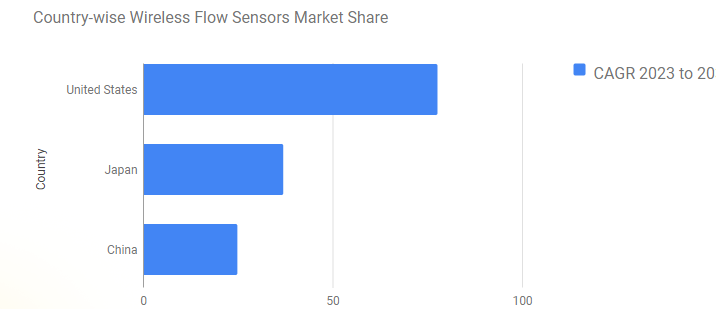According to Future Market Insights’ prediction, the wireless flow sensors market will reach USD 2.3 billion in 2023 and USD 21.1 billion by 2033. The market will witness a market growth of 25% CAGR from 2023 to 2033. Wireless flow sensors play a vital role in the emergence of the Internet of Things (IoT).
Real-time data can be sent wirelessly through these sensors, enabling seamless integration with IoT platforms. The demand for wireless flow sensors is likely to increase as the Internet of Things continues to grow.
A wireless flow sensor is able to operate without wires, allowing for easy installation and flexibility in placement. The flow rates can be monitored and controlled remotely in various applications, including water management, industrial processes, and HVAC systems. Maintenance costs can be reduced and operational efficiency can be enhanced using this technology. A wireless flow sensor provides continuous and accurate measurements of the flow rate, which makes it easier to manage resources. Inefficiency can be identified, processes can be optimized, and overall system performance can be improved by analyzing data collected from these sensors. As a result, cost savings can be achieved, energy can be conserved, and productivity can be increased.
Get Exclusive Sample Copy of the Report: https://www.futuremarketinsights.com/reports/sample/rep-gb-17509
Flow sensors with wireless communication offer scalability, since multiple sensors can be connected without limitations imposed by wired connections. Monitoring complex systems with numerous points of flow is made possible by this flexibility, allowing a comprehensive view of the entire process. Wireless flow sensors are easier to install and cost less than traditional wired sensors. By eliminating physical wiring, users can save time and money on installation by reducing cabling infrastructure. Furthermore, wireless sensors tend to have longer battery life and require less maintenance than wired ones. These factors will likely grow demand in growing years
Key Takeaways from the Wireless Flow Sensors Market:
- By-technology Wi-Fi market demand is forecasted to hold a CAGR of 24.4% by 2033.
- Research from FMI says the United States will have a market worth US$3.9 billion by 2033.
- South Korea’s wireless flow sensor market is projected to grow at a CAGR of 24.6% from 2023 to 2033.
- Industry reports predict that by 2033, China’s wireless flow sensors sector will total US$ 4.6 billion in revenue.
- Forecasts indicate a 24.9% CAGR for the wireless flow sensors market in Japan during the forecast period.
- The water & waste water management segment is expected to dominate wireless flow sensors by 2033 with a CAGR of 24.1%.
- By 2033, the United Kingdom will dominate the market for wireless flow sensors with a CAGR of 24.6%.
Wireless Flow Sensors Manufacturing: How are Key Players Transforming it?
There are a variety of wireless flow sensors on the market at competitive prices from global manufacturers. Market players include the following
- ABB Ltd
- Analog Devices, Inc.
- Emerson Electric Company
- General Electric Company
- Honeywell International, Inc.
- Kongsberg Gruppen ASA
- Maxim Integrated Products, Inc
- Microchip Technology, Inc
- NXP Semiconductors NV
- Panasonic Corporation
Get Full Report Now: https://www.futuremarketinsights.com/checkout/17509

Recent Developments
- In June 2023, a new reference flow is now available for the design of radio-frequency integrated circuits (RFICs) based on Samsung Foundry’s 14LPU process technology, developed by Ansys and Synopsys, Inc. Synopsys’ analog/RF design and verification solution along with Ansys’ golden signoff electromagnetic analysis makes it easier for mutual customers to optimize RFIC designs.
- In June 2023, Telekom joined forces with Helium to build IoT Creators, a platform to support IoT networks. The Helium LoRaWAN Network Server (LNS) will be incorporated into IoT Creators’ platform to facilitate onboarding and managing devices. With IoT Creators, sensor deployers are able to deploy smart devices wirelessly agnostic, enabling them to utilize cellular and LoRaWAN networks as needed.



